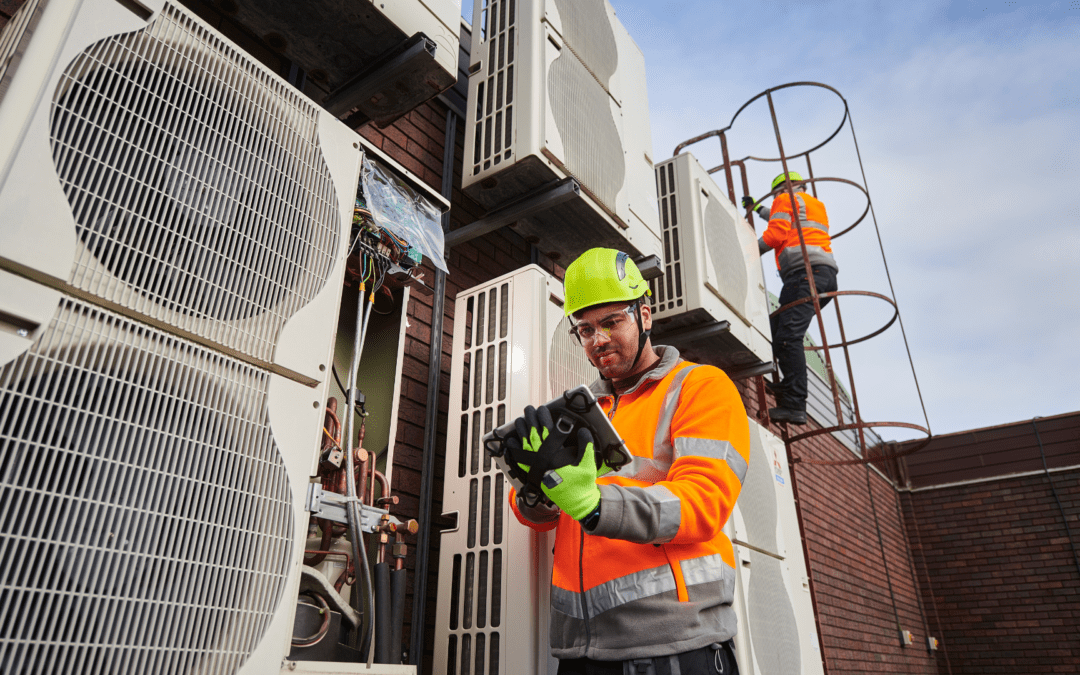Energy efficiency is vital in commercial buildings for both environmental and cost reasons. Modern businesses increasingly focus on eco-friendly and cost-effective air conditioning solutions. This necessity aligns with environmental and economic goals, underscoring its importance for today’s enterprises.
IACS recognises the importance of energy-efficient climate control in commercial spaces. Leveraging over two decades of experience, we offer sustainable and cost-saving air conditioning options across Australia. Our guide introduces the latest energy-saving technologies and practices to significantly reduce environmental impact and operational costs.
Variable refrigerant flow (VRF) systems
Variable refrigerant flow (VRF) systems are among the most energy-efficient HVAC technologies available for commercial buildings. These systems adjust the refrigerant flow based on the current demand, ensuring optimal efficiency, providing precise temperature control to different areas or rooms within a building, both heating and cooling to meet the needs of the space. VRF systems are renowned for their ability to operate at varying capacities, which significantly reduces energy waste and leads to lower utility bills.
The essence of VRF technology lies in its ability to control the amount of refrigerant flowing to each of these zones, enabling the system to respond dynamically to the specific demands of each area. This not only ensures optimal comfort but also significantly reduces energy consumption. By operating at varying speeds, VRF systems can work only at the required capacity, avoiding the energy wastage associated with traditional on-off systems. This adaptability is especially beneficial in a city like Perth, where temperature variations between seasons and even within a day can be considerable.
VRF systems use sophisticated controls that provide users with detailed management capabilities over their environment. Users can adjust settings for individual rooms or zones from a single interface, enhancing both comfort and efficiency. The integration of smart technology also allows for remote monitoring and control, further optimising energy usage and reducing operational costs.
By precisely matching the cooling or heating output with the demand, these systems minimise energy waste, leading to lower electricity bills and a reduced carbon footprint. VRF technology offers a forward-thinking solution for air conditioning needs, aligning with both environmental goals and the comfort requirements of its residents and businesses.
Smart HVAC controls
Advancements in technology have led to the development of smart HVAC controls, which optimise air conditioning systems for maximum efficiency. These controls use sensors and algorithms to adjust temperatures and airflow based on real-time occupancy and weather conditions. Smart HVAC controls can significantly reduce energy waste by ensuring that air conditioning is provided only when and where it is needed. Additionally, these systems often include remote monitoring and management capabilities, allowing building managers to adjust settings and monitor performance from anywhere.
High-efficiency air conditioners
Investing in high-efficiency air conditioners is an effective strategy for reducing energy use in Australian commercial buildings. These modern units are designed to consume less electricity without sacrificing cooling performance. It’s essential to select air conditioners with a high Energy Efficiency Ratio (EER), as this reflects superior energy performance. Although these systems may have a higher upfront cost, the long-term energy bill savings can make high-efficiency units a financially smart choice for businesses aiming to lower their energy consumption and environmental impact.
Regular maintenance and servicing
Regular maintenance and servicing of air conditioning systems are critical for ensuring they operate at peak efficiency. A well-maintained AC unit can perform more effectively, consuming less energy to achieve the desired cooling effect. Key maintenance tasks include cleaning or replacing air filters, checking and sealing ductwork leaks, and ensuring that all system components are in good working order. Scheduling regular professional inspections can help identify and rectify issues before they lead to increased energy consumption or system failures.
Upgrading insulation and sealing
Improving a building’s insulation and sealing can significantly reduce the cooling load on air conditioning systems. Effective insulation helps keep warm air out and cool air in, lessening the demand on AC units. Paying attention to windows, doors, and walls by adding or upgrading insulation materials, installing double-glazed windows, and using weather stripping or caulking to seal leaks can make a substantial difference in energy consumption. These measures not only improve the efficiency of air conditioning systems but also enhance overall building comfort.
Implementing shading and reflective materials
External shading devices, such as awnings, blinds, and vegetation, can block direct sunlight, significantly reducing the amount of heat entering a building. Internal shading options, like curtains and reflective window films, can also help by reflecting heat away from the interior. For commercial buildings with large glass facades, considering external shading solutions or applying reflective materials can make a substantial impact on reducing cooling requirements and enhancing energy efficiency.
Strategic air conditioning usage
Adopting strategic practices for air conditioning usage can lead to significant energy savings. Setting thermostats to a comfortable but higher temperature in summer (e.g. 24–25°C) can reduce the workload on AC units. Utilising programmable thermostats or building management systems to adjust temperatures based on occupancy and time of day can further optimise energy use. Encouraging occupants to use natural ventilation during cooler parts of the day or in less critical areas of the building can also decrease reliance on mechanical cooling.
Conclusion
Transitioning to energy-efficient air conditioning systems is not only environmentally crucial but also economically sensible. IACS is committed to assisting Australian businesses in achieving these goals efficiently. We encourage dialogue on how we can support your transition to more efficient air conditioning solutions. Our goal is to partner with you for a sustainable and cost-effective future. This approach ensures that businesses can contribute positively to the planet while also benefiting from lower operational costs.
Reach out to IACS today to discover how our expertise can streamline your air conditioning efficiency. Let’s work together to achieve a sustainable and economically beneficial future for your enterprise. Contact us now to start the conversation.

